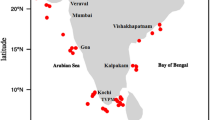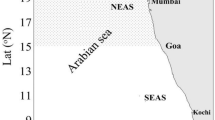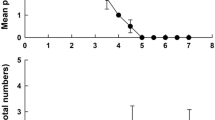Abstract
Favella panamensis Kofoid and Campbell, 1929 is seasonally abundant in meso- to polyhaline waters of Chesapeake Bay and Indian River, Florida, USA, where it reaches densities of 103 cells l-1. During the summers of 1986–1992. F. panamensis populations of the two estuaries were commonly infected by the parasitic dinoflagellate Duboscquella aspida Cachon, 1964. The intracellular phase of the parasite reached maturity in ∼21 h (30 °C) and consumed ∼35% of the host's biomass. Infections were not typically lethal to F. panamensis, but sometimes forced the host from its lorica. Several D. aspida were found in the cytoplasm of many hosts, and the number of parasites infection-1 was directly related to infection level. Parasite prevalence averaged 24.0 and 11.5% with mean number of parasites infection-1 being 1.5 and 1.3 for Chesapeake Bay and Indian River samples, respectively. D. aspida was estimated to remove up to 68% of host standing stock d-1 with a mean of ∼10% for all samples. The average impact of parasitism on F. panamensis populations was somewhat less than would be expected from copepod grazing.
Similar content being viewed by others
References
Ayukai T (1987) Predation by Acartia clausi (Copepoda:Calanoida) on two species of tintinnids. Mar microb Fd Webs 2:45–52
Azam F, Fenchel T, Field JG, Gray JS, Meyer-Reil LA, Thingstad F (1983) The ecological role of water column microbes in the sea. Mar Ecol Prog Ser 10:257–263
Ball GH (1969) Organisms living on and in protozoa. In: Chen T-T (ed) Research in protozoology, Vol 3. Pergamon Press, Oxford p 565–718
Bockstahler KR, Coats DW (1993 a) Spatial and temporal aspects of mixotrophy in Chesapeake Bay dinoflagellates. J eukaryot Microbiol (J Protozool) 40:49–60
Bockstahler KR, Coats DW (1993 b) Grazing of the mixotrophic dinoflagellate Gymnodinium sanguineum on ciliate populations of Chesapeake Bay. Mar Biol 116:447–487
Brownlee DC, Jacobs F (1987) Mesozooplankton and microzooplankton in the Chesapeake Bay. In: Majumdar SK, Hall LW Jr., Austin HM (eds) Containment problems and management of living Chesapeake Bay resources. Pennsylvania Academy of Sciences, Easton, Pennsylvania, p 217–269
Cachon J (1964) Contribution à l'étude des péridiniens parasites. Cytologie, cycles évolutifs. Annls Sci nat (Sér Zool)6:1–158
Cachon J, Cachon M (1987) Parasitic dinoflagellates. In: Taylor FJR (ed) The biology of dinoflagellates. Blackwell Scientific Publishers, Oxford, p 571–610
Campbell AS (1942) The oceanic Tintinnoina of the plankton gathered during the last cruise of the Carnegie, Carnegie Institute of Washington Publication 537, Washington DC
Caron DA, Swanberg NR (1990) The ecology of planktonic sarcodines. Rev aquat Sci 3:147–180
Chatton, É (1920) Les péridiniens parasites. Morphologie, reproduction, ethologie. Arch Zool exp gen 59:1–475
Coats DW, Heinbokel JF (1982) A study of reproduction and other life cycle phenomena in planktonic protists using an acridine orange fluorescence technique. Mar Biol 67:71–79
Coats DW, Heisler JJ (1989) Spatial and temporal occurrence of the parasitic dinoflagellate Duboscquella cachoni and its tintinnine host Eutintinnus pectinis in Chesapeake Bay. Mar Biol 101:401–409
Dolan JR, Coats DW (1991 a) A study of feeding in predacious ciliates using prey ciliates labeled with fluorescent microspheres. J Plankton Res 13:609–627
Dolan JR, Coats DW (1991 b) Preliminary prey digestion in a predacious estuarine ciliate, Euplotes woodruffi, and the use of digestion data to estimate ingestion. Limnol Oceanogr 36:558–565
Duboscq O, Collin B (1910) Sur la reproduction sexuée d'un protiste parasite des tintinnides. CR hebd Séanc Acad Sci, Paris 151:340–341
Galigher AE, Kozloff EN (1971) Essentials of practical microtechnique, 2nd edn. Lee and Febiger, Philadelphia
Gifford DJ (1991) The protozoan-metazoan trophic link in pelagic ecosystems. J. Protozool 38:81–86
Hansen PJ (1991) Dinophysis — a planktonic dinoflagellate genus which can act both as a prey and a predator of a ciliate. Mar Ecol Prog Ser 69:201–204
Heinbokel JF (1988) Reproductive rates and periodicities of oceanic tintinnine ciliates. Mar Ecol Prog Ser 47:239–248
Laval-Peuto M (1981) Construction of the lorica in Ciliata Tintinnina. In vivo study of Vavella ehrenbergii: variability of the phenotypes during the cycle, biology, statics, biometry. Protistologica 17:249–272
Montagnes DJS, Lynn DH (1987) A quantitative Protargol stain (QPS) for ciliates: method description and test of its quantitative nature. Mar microb Fd Webs 2:83–93
Pierce WR, Turner JT (1992) Ecology of planktonic ciliates in marine food webs. Rev aquat Sci 6:139–181
Pierce WR, Turner JT (1993) Global biogeography of marine tintinnids. Mar Ecol Prog Ser 94:11–26
Reid PC, Turley CM, Burkill PH (1991) Protozoa and their role in marine processes. NATO ASI Series G: Ecological Sciences, 24. Springer-Verlag, Berlin
Robertson JR (1983) Predation by estuarine zooplankton on tintinnid ciliates. Estuar cstl Shelf Sci 16:27–36
Schnepf E, Elbrächter M (1992) Nutritional strategies in dinoflagellates: a review with emphasis on cell biological aspects. Eur J Protistol 28:3–24
Sherr BF, Sherr EB, Hopkinson CS (1988) Trophic interactions within pelagic microbial communities: indications of feedback regulation of carbon flow. Hydrobiologia 159:19–26
Sellner KG, Brownlee DC (1990) Dinoflagellate-microzooplankton interactions in Chesapeake Bay. In: Granéli E, Sondstrom B, Edler L, Anderson DM (eds) Toxic marine phytoplankton. Elsevier, New York, p 221–226
Stoecker DK, Capuzzo JM (1990) Predation on protozoa: its importance to zooplankton. J Plankton Res 12:891–908
Stoecker DK, Davis LH, Anderson DM (1984) Fine scale spatial correlations between planktonic ciliates and dinoflagellates. J Plankton Res 6:829–842
Stoecker DK, Davis LH, Provan A (1983) Growth of Favella sp. (Ciliata: Tintinnina) and other microzooplankters in cages incubated in situ and comparison to growth in vitro. Mar Biol 75:293–302
Stoecker DK, Egloff DA (1987) Predation by Acartia tonsa Dana on planktonic ciliates and rotifers. J exp mar Biol Ecol 110:53–68
Stoecker DK, Govoni JJ (1984) Food selection by young larval gulf menhaden (Brevoortia patronus). Mar Biol 80:299–306
Stoecker DK, Guillard RRL, Kavee RM (1981) Selective predation by Favella ehrenbergii (Tintinnia) on and among dinoflagellates. Biol Bull mar biol Lab, Woods Hole 160:136–145
Stoecker DK, Michaels EA, Davis LH (1987 a) Grazing by the jellyfish, Aurelia aurita, on microzooplankton. J Plankton Res 9:901–915
Stoecker DK, Sanders NK (1985) Differential grazing by Acartia tonsa on a dinoflagellate and a tintinnid. J Plankton Res 7:85–100
Stoecker DK, Verity PG, Michaels AE, Davis LH (1987 b) Feeding by larval and post-larval ctenophores on microzooplankton. J Plankton Res 9:667–683
Swanberg NR, Caron DA (1991) Patterns of sarcodine feeding in epipelagic oceanic plankton. J Plankton Res 13:287–312
Author information
Authors and Affiliations
Additional information
Communicated by J. P. Grassle, New Brunswick
Rights and permissions
About this article
Cite this article
Coats, D.W., Bockstahler, K.R., Berg, G.M. et al. Dinoflagellate infections of Favella panamensis from two North American estuaries. Marine Biology 119, 105–113 (1994). https://doi.org/10.1007/BF00350112
Received:
Accepted:
Issue Date:
DOI: https://doi.org/10.1007/BF00350112




